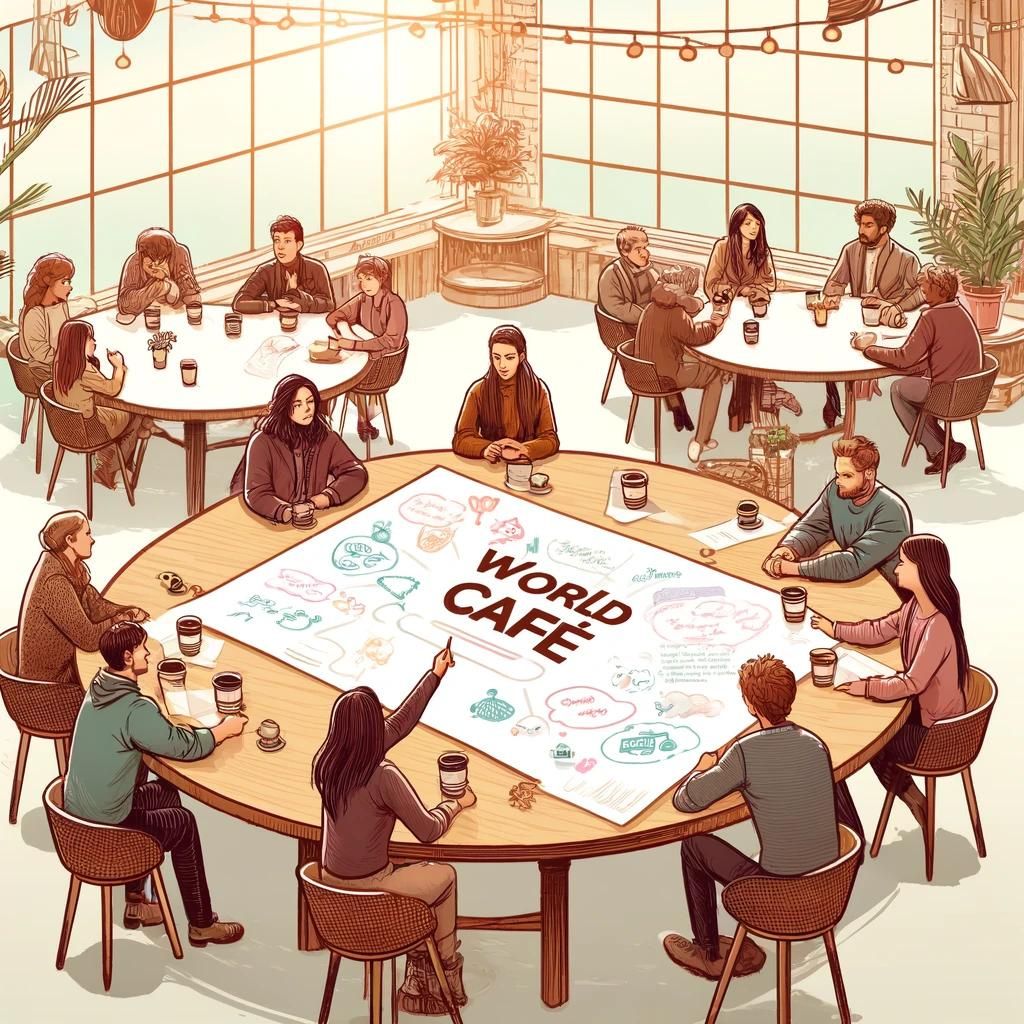Learn about a structured conversational process for open collaboration and discussion
In an age where short digital communication is common and collaborative and genuine dialogue is rare, the World Café Method is a simple and a powerful tool to foster deep, meaningful conversations in various settings – from corporate environments, to community dialogue or listening sessions, to educational workshops. This participatory design process is helpful at leveraging collective intelligence, encouraging collaboration, and exploring complex topics through discussion. We often recommend a World Café approach to people who want an interactive, discussion filled event – but may be newer to facilitation. Instead, it’s simpler when you can just provide the space and host. Here’s a guide on what the World Café Method entails, how you can run your own session, alongside practical examples and resources to assist hosts and facilitators.
Understanding the World Café Method
The World Café is a structured conversational process intended to facilitate open and intimate discussion, and share knowledge in groups of all sizes. The method mimics a café setting, wherein participants discuss a topic at several small tables, and switch tables periodically, cross-pollinating ideas and insights. It’s also fun to have coffee, tea, and music like your favorite cafe. This setting is conducive to networking, knowledge sharing, and community building, making it an effective strategy for brainstorming, problem-solving, and strategic planning sessions.
Key Principles
To harness the full potential of the World Café Method, adhering to its seven foundational principles is crucial:
- Set the Context: Define the purpose of the café. What is the central question or theme that will guide the discussion?
- Create Hospitable Space: Arrange a welcoming and comfortable environment that encourages openness and dialogue.
- Explore Questions That Matter: Craft questions that are thought-provoking and relevant to the participants’ interests and the session’s goals.
- Encourage Everyone’s Contribution: Foster an atmosphere where every voice is valued and participants are encouraged to contribute their perspectives and listen actively.
- Connect Diverse Perspectives: Facilitate the sharing of insights across groups to weave a rich tapestry of understanding.
- Listen Together for Patterns and Insights: Promote collective reflection to identify emerging themes, insights, and deeper questions.
- Share Collective Discoveries: Conclude the session by summarizing the discussions, shared ideas, and any identified action steps.
How to Run Your Own World Café Session
- Preparation:
- Define the Purpose: Clearly articulate the objective of the World Café to shape the structure and content of your session.
- Choose a Comfortable Venue: Ensure the space is arranged to resemble a café, with small tables, each seating ideally four to five people but you can have more. Decorations and refreshments can enhance the café ambiance.
- Develop Engaging Questions: Design three to four questions that build upon each other, encouraging deeper exploration as the session progresses.
- Execution:
- Welcome and Introduction: Start by explaining the purpose, process, and expectations to the participants.
- First Round of Conversation: Begin with the first question, allowing approximately 10-20 minutes for discussion.
- Table Switching: Instruct participants to move to a new table, carrying key insights with them. One person, the “table host,” remains to summarize the previous discussion to new members.
- Subsequent Rounds: Repeat the conversation rounds for each question, with participants switching tables each time.
- Harvesting: Conclude with a plenary session where key insights, patterns, and collective wisdom are shared with the whole group.
- Follow-Up:
- Document the outcomes and share them with participants.
- Discuss next steps, actions, or decisions that emerged from the session.
Practical World Café Examples
- Corporate Strategy Meetings: Utilize the World Café for strategic planning, allowing employees across levels to contribute ideas for the organization’s vision and strategic direction.
- Educational Workshops: Facilitate learning and discussion on complex topics, encouraging students to engage deeply with the material and each other.
- Community Engagement: Gather community input on local projects or initiatives, ensuring diverse voices are heard and considered.
Resources for Hosting or Facilitating a World Café
- The World Café Community Foundation (www.theworldcafe.com): Offers a wealth of resources, including a hosting guide, tools, and stories of World Café events from around the globe.
- Books: “The World Café: Shaping Our Futures Through Conversations That Matter” by Juanita Brown and David Isaacs is an essential guide that provides a comprehensive overview of the method.
- Online Forums: Engage with the World Café online community to share experiences, ask questions, and get advice from seasoned facilitators.
The World Café Method stands out not just as a tool for effective communication but as a tried and true method to enable the power of conversation in an event. By embracing this approach, facilitators and participants alike embark on a journey of collective inquiry, exploration, and discovery, with the potential to unearth innovative solutions and forge stronger communities. Whether you’re looking to inspire change, foster learning, or simply engage in meaningful dialogue, the World Café offers a proven framework for conversations that truly matter.
Please contact us if you ware interested in help designing and facilitating your special collaboration event.
